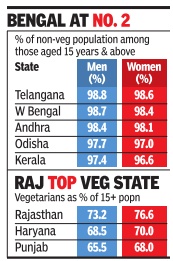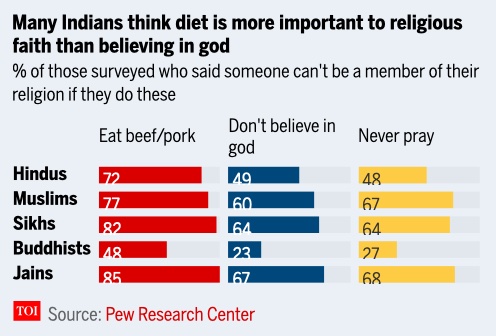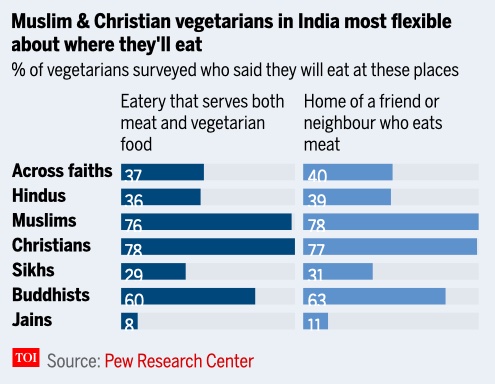Dietary habits, vegetarianism: India


From: April 14, 2022: The Times of India

From: April 14, 2022: The Times of India
This is a collection of articles archived for the excellence of their content. |
Extent of vegetarianism
States with the most and least vegetarians
The Times of India, Jun 11 2016
At 99% of population, Telangana tops list of non-vegetarian states
Telangana has the highest proportion of meat-eaters in India with almost 99% of its residents being non-vegetarians, a Registrar General of India survey of people aged 15 years and above has revealed. An almost equal percentage of men (98.8) and women (98.6) in the state are non-vegetarians. West Bengal, Andhra Pradesh, Odisha and Kerala follow Telangana among the states with the highest non-vegetarian population. Rajasthan, Punjab and Haryana top the list of states with the highest number of vegetarians.
Overall, the percentage of non-vegetarians across the country has dropped from 75% in 2004 to 71% in 2014.
Experts say meat consumption in Telangana reflects traditional eating habits of its people. “People in Telangana consume a lot of lamb and chicken even for breakfast, said food blogger Sabyasachi Raychaudhuri.“...different body parts of animals such as gurda (kidney), bheja (brain), paya (trotters) among others are consumed. Many people also consume rabbits, emu and quail. Experts said changing lifestyles could have contributed to the increase in meat consumption in the state besides religion. They added that most of those surveyed could be from Hyderabad, which has a high percentage of meat-eaters.
Abundance of livestock in Telangana, too, contributes to higher consumption of meat. The state has the second highest number of sheep and the fourth highest poultry count in the country.
70% of Indians eat non-veg, veg diet getting popular
The Times of India, June 9, 2016
Health Issues Are Changing Palate: Experts
Even as India is rapidly growing as a major market for chicken and fish, awareness about health benefits of a vegetarian diet may also be catching up fast among people. Though 70% of Indians above 15 years of age are still non-vegetarians, the numbers are expected to decline, a nationwide survey conducted in 2014 and released recently by the Registrar General of India (RGI) showed. In 2004, the prevalence of non-vegetarianism was pegged at about 75%.
Experts said increasing health awareness, coupled with rising burden of lifestyle diseases like heart disorders, diabetes and cancer, may be influencing the Indian palate.
Several international researches and studies have found vegetarians leading a healthier life compared to meateaters. Incidence of diseases such as pancreatic cancer and respiratory problems are also less common among vegetarians than in those who consume meat regularly .
Besides, religiosity and changing lifestyles could also be contributing to the changing trend, experts said.
“It is possible that the purchase wallet for non-vegetari an foods is now being diverted towards ready to eat, processed or packaged foods because there is an increasing trend of cooking less at home,“ said Dr Shikha Sharma, a leading nutritionist and founder and managing director of NutriHealthSystems.
However, food consumption data from NSSO as well as OECD-FAO (Organisation of Economic Cooperation and Development, UN Food and Agriculture Organisation) Agricultural Outlook 2014, showed that growth in per ca pita consumption of chicken and fish outpaced the growth in consumption of wheat, rice and sugar. Chicken consumption grew the most with India becoming the fourth-fastest growing market for the product in the world. According to the OECD-FAO 2014 data, chicken consumption in India grew at an annual growth rate of 5.9% between 1992 and 2013.
The RGI data also highlighted a contrast with rising purchasing power which should otherwise allow more consumption of non-vegetarian meals. The latest NSSO data showed that at higher ends of the income table, consumption of milk, eggs, meat and processed foods rose. In urban India, the richest 5% consume the fewest cereals and the most derivatives of cereals like bread and noodles. However, in rural India, the richest 5% still consume the most cereals.